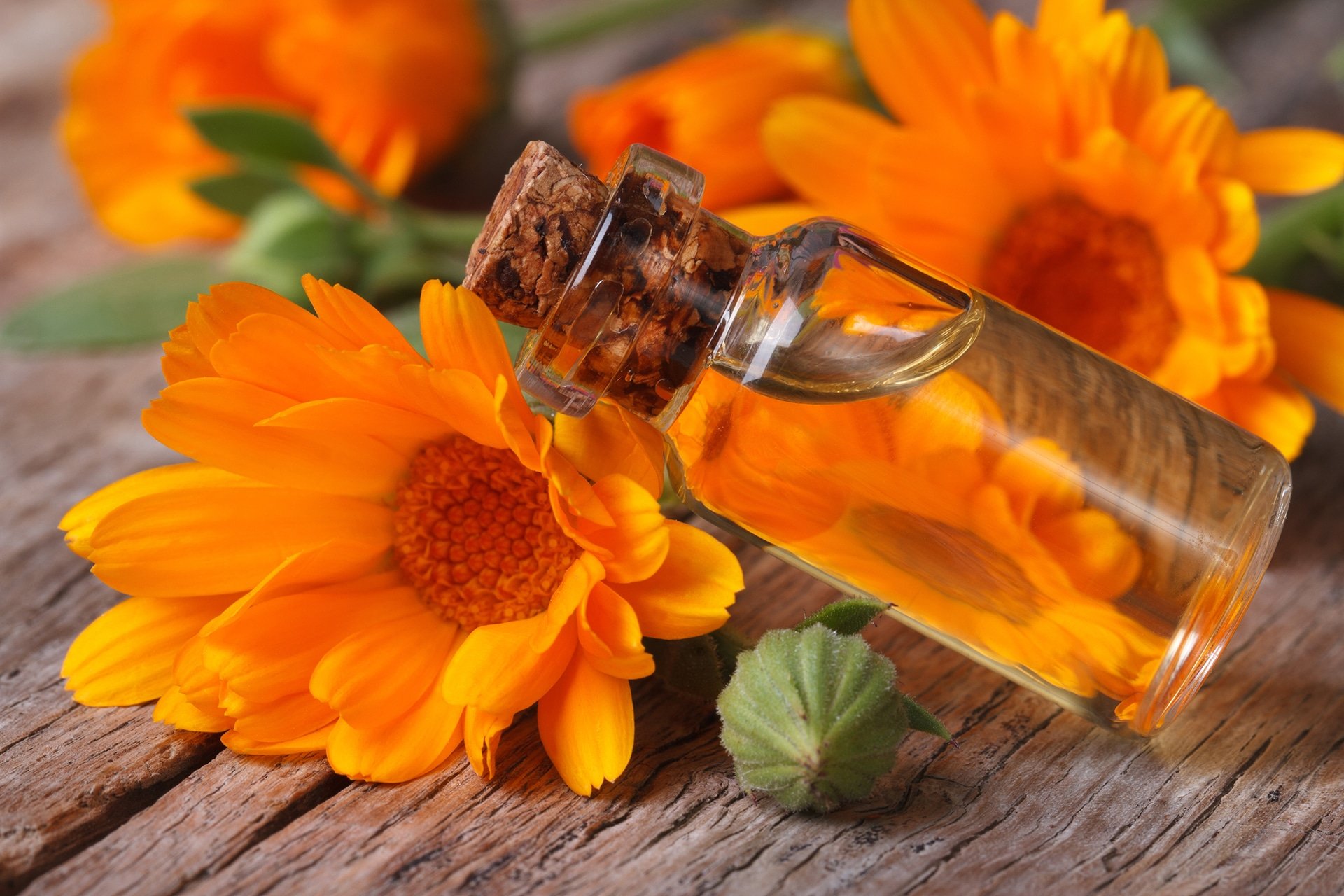Summer means more outdoor activities, and time spent outdoors means more ouchies like bug bites and sunburns. Thankfully there are a number of plant allies perfect for addressing our summertime skin complaints; Calendula (Calendula officinalis) is one of my personal favorites and can be made into a versatile Calendula oil.
This powerful medicinal plant is beloved around the world, finding its way into countless home remedies and commercial skin care products, especially on account of its skin-restorative abilities. Calendula is a premier skin support herb with broad medicinal use.
Applied externally, Calendula is a powerful wound healer: soothing traumatized, inflamed tissue and stimulating rapid growth of healthy skin cells.1 Calendula not only helps wounds heal quicker, it reduces their risk of becoming infected and scarred.2 The astringent, anti-inflammatory, and antioxidant properties of the herb grant its ability to not only treat, but prevent, sunburns3 – while its moistening nature hydrates dry, itchy skin.
Calendula also has an affinity for the lymphatic system: addressing fluid stagnation, supporting the elimination of toxins, and relieving conditions such as varicose veins, bruises, and sore muscles. Massaging Calendula oil into your skin daily can help to achieve healthy, toned skin.

Making a Calendula Oil Infusion
Preparing the Calendula
For the best medicine, buy the freshest dried herbs available to you. The strongest medicine is in the green base of the Calendula flower, so be sure to select whole flower heads with bright orange or yellow petals. If you grow your own, thoroughly dry the plant material to reduce the risk of mold growth in your Calendula oil.
Next, grind or chop the plant material to increase the surface area. Aim for coarse particle sizes no smaller than French press coffee grounds. If powdered too finely, it will be difficult to strain the herb from the oil. This grinding step is optional but will produce a stronger extraction.

Ethanol Digestion
Pre-treating dried herbs with alcohol helps to break down the cell walls, bringing constituents – such as resin – to the cell surface so that it can be picked up by the solvent. This intermediary step is optional, but will greatly aid extraction in your Calendula oil. Any high-proof alcohol can be used.
Choosing an Oil
It is important to use fresh, quality oils for your herbal extraction. For topical medicine, you want an oil that will readily absorb into skin and is non-comedogenic. Take into consideration the purpose your finished oil will be serving, and the extraction method you’ll be using.
If you’ll be using heat extraction methods, use stable, heat tolerant oils like sesame (Sesamum indicum), grapeseed (Vitis vinifera), and jojoba (Simmondsia chinensis).
Expensive, less stable oils should be reserved for smaller batches, while products made in large quantities should be made primarily from more shelf-stable and economical oils. Grapeseed is an inexpensive carrier oil containing polyphenols and vitamin E. Polyphenols are healing and protective for body and scalp, and grant the oil stability and increased shelf life.

Herb-to-Oil Ratio
You can prepare the Calendula oil infusion using two different approaches: folk and weight-to-volume.
With the folk method, loosely pack your herbs into a jar, leaving an inch of space at the top. Pour oil over the plants until they are completely submerged under oil. Fill oil nearly to the jar brim to reduce oxidation of the oil and molding of the plant matter.
In the weight-to-volume method, herbs and oil are typically combined in a 1:5 ratio, but I find that 1:10 allows for easier handling. To get these proportions, use ten times the amount of oil (measured by volume) for every one part of herb (measured by weight). For example: 25 grams of herbal material to 250 milliliters of oil.
Choosing an Extraction Method
Oil infusions can be prepared with or without heat. The heatless process, or maceration, is slower but doesn’t damage the delicate constituents in the plants or carrier oils. You can use heat to speed up the infusion process, reducing the extraction time from weeks to only a few hours. However, heated methods require more mindfulness to ensure the oil doesn’t get ruined. Resinous herbs like Calendula are best extracted using heat and longer processing time.
Maceration Method
Place the sealed jar in a sunny window. Cover with a paper bag in order to protect from damaging UV light. Shake daily for four to six weeks.

Water Bath Method
Place the prepared jar into a heating vessel with water. The water level should be about halfway up the side of the jar, and a rack should be set between the vessel and jar. I prefer to use a pot on the stovetop, heated to a simmer, then turned off to let the herb-oil mixture infuse. I repeat this process several times over a 24-hour period, usually every time I walk into the kitchen. The infusion is done when the oil takes up color from the herbs.
Alternatively, you can set up a water bath in a Crock-Pot and process on the lowest setting for four to six hours, or in a yogurt maker/electric pressure cooker with “yogurt” setting for eight to 10 hours. Note: using a yogurt maker/yogurt setting produces an ultra-low heat (110-115ºF) water bath only appropriate for light aromatic plants, and not resinous ones like Calendula which require more heat.
What’s In A Name?
Confusingly, the plant known as Calendula (Calendula officinalis L.) shares the same common name of “marigold” with plants of the Tagetes genus. Calendula officinalis L. is part of the genus Calendula, which contains about 10 to 15 species4 5 of plants native to temperate parts of Africa and Eurasia – with northwest Africa being the center of distribution.6 Commercial use focuses on the Calendula officinalis L species, but many other Calendula species are used medicinally.

How to Make Calendula Oil
Follow these steps to make your own Calendula oil at home. This process can also be used to make other herbal oils.
What you’ll need…
- Whole dried Calendula flowers (enough to fill your jar)
- Liquid oil of your choice (enough to cover the plant material)
- High-proof alcohol (optional)
- Put the Calendula flowers in a food processor or blender. Pulse until ground coarsely.
-
Optional ethanol digestion: Put the Calendula in a bowl and spritz with a small amount of alcohol, using just enough to moisten the flowers. Cover the bowl and leave for several hours.
-
Using the folk method or 1:10 ratio, add the Calendula and oil to a dry, sterilized heat-proof jar. Make sure the herb is completely submerged under the oil.

- Cover the jar with a lid, and shake.
-
Use the extraction method of your choice: maceration or water bath. If using heat, be sure to let the oil cool somewhat before straining.
-
Filter the oil through a metal mesh strainer or fine woven cloth. I prefer to use nylon strainer bags as they don’t absorb oil and are inexpensive. You can also use a potato ricer to squeeze as much oil out of the spent plant material as you can.


- Store the oil in a glass jar or bottle in a cool, dark place. Shelf life is 1 to 2 years.
The infused Calendula oil can be used as is, or turned into skincare products such as salt scrubs, lotion bars, and medicinal ointments.
Safety: Calendula is safe for babies and nursing parents. Those sensitive to other members of the Asteraceae family (such as ragweed [Ambrosia spp.] and chamomile [Matricaria recutita]) should use caution when using Calendula for the first time. Stop use immediately if signs of rash occur. Since they trap moisture and heat, it is not advised to apply oils to fresh burns, fungal infections, and leaky skin conditions. For these instances, water-based preparations such as Calendula poultices and soaks would be more appropriate.










There is no direction on using the alcohol to help break down the sells. I have not seen this advice before. Please explain the process.
I found the directions, must have rolled by them to quick. Thank you
.
Can the alcohol be used on any of the dried herbs, or only certain ones?
You may use alcohol with any dried herbs when making herb-infused oils. Enjoy!
can i use this oil to make a room spray?
I wouldn’t use an oil in a room spray. The oil will stain fabrics and gets sticky, even in small droplets. I use vinegar or alcohol as the medium for extracting the herb and then dilute with water for a room spray or cleaning spray (which does both clean hard surfaces and create a pleasant scent).
great instructions! more detail than I have found elsewhere. Do you recommend air drying or using a dehydrator for quicker drying? thanks in advance.
The answer really depends on your climate. I live in a dry climate and I air-dry my herbs very successfully in a variety of ways. If you live in a humid climate, you may need to use a dehydrator for calendula in particular. The denser the herb/flower, the more challenging it can be to dry.
You can try it out regardless of where you live by laying the flowers out in a single layer on a screen of some kind. I have used picture frames with screen material stapled over the opening. I also use wide wicker baskets. I have a 8-layer mesh hanging herb dryer now. Always air-dry in the shade with airflow, for best results.
Best wishes!
Hello! Great post! Can citrus acids be used instead of alcohol to “digest” the plant matter?
Thanks so much for your hard work and sharing!